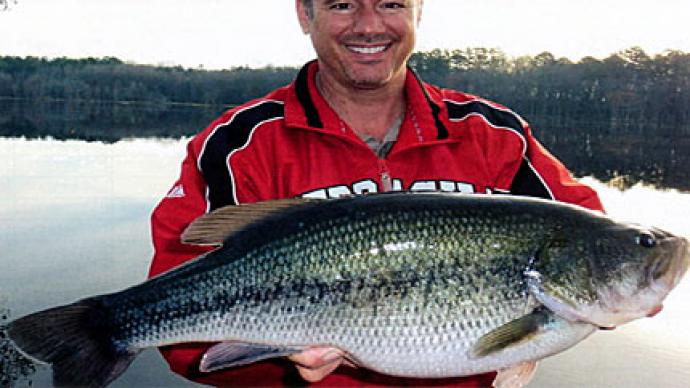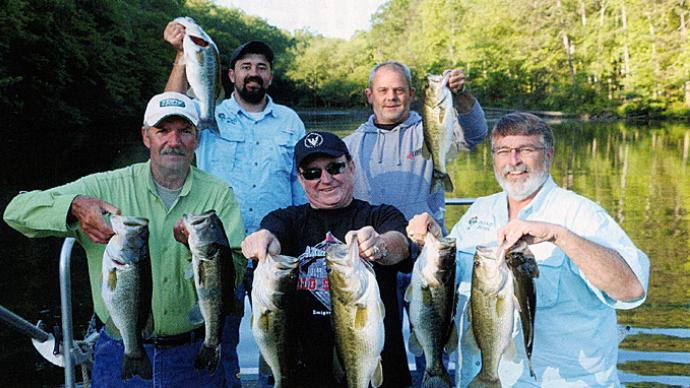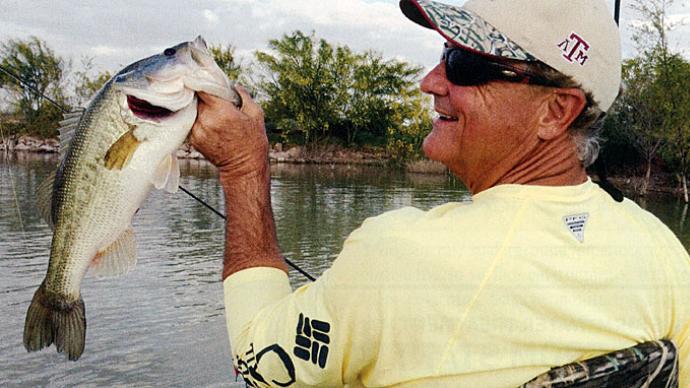
Largemouth bass are experts at reproduction in ponds, especially southern ponds. They'll often start spawning in March and, if conditions are right, they can fill the pond with fingerling bass by early summer. Thus, bass in southern ponds tend to overpopulate and go bass-crowded when harvest is light. Bass-crowded is the situation when you have too many small bass that eat up most of the prey, so they grow slowly and can be quite thin.
Pond Boss Magazine has long beaten the drum of harvest to prevent bass-crowding and to promote fast growth and large sizes. After all, the way to a trophy bass is through its stomach. It is all about channeling more of the biomass into fewer, bigger bass.
I like to think about it in a rather simplistic way. Suppose a given pond can support 1,000 pounds of bass. This is the pond's carrying capacity based on the current productivity of the pond. If you change feeding, fertilization, or water quality, this can affect the carrying capacity, but otherwise it is relatively stable through time.
Those 1,000 pounds of bass can be distributed to many size combinations. You might have 1,000 bass that weigh 1 pound each, or 500 2-pounders, or 200 5-pounders, or 100 10-pounders. More likely the pond will have a combination of sizes, but regardless of the size distribution, the pond can only support 1,000 pounds of bass. Thus, to grow big bass, you need to have fewer bass and direct all the prey resources into those few fish.
As you can see, removing smaller fish and slow-growing fish is very important. In the theoretical pond with 1,000 1-pound bass, if you can reduce the population to 200 fish and keep it there, eventually the population will be composed of 200 fish that average 5 pounds each. The 200 bass will use the available food resources to reach carrying capacity.
In theory, this relationship is obvious. In practice, killing a small bass can be very difficult for many pond owners, and killing a lot of small bass can be too much to bear. Thus, many ponds in the southern U.S. end up with too many bass that eliminate the available food resources, resulting in slow growth, poor condition, and small size, a.k.a., a bass-crowded situation.
Perhaps you find yourself in this situation. Maybe you purchased a property that was unmanaged for many years, or maybe you just didn't have the free time to harvest on schedule. Regardless, you possess a bass-crowded pond and want to remedy the situation. The solution seems obvious, right? Take out bass!
Our friend Dave Willis attempted this approach in a pond in South Dakota with a high density, slow-growing bass population. He and his students harvested large numbers of bass less than 12-inches over a 3-year period. After 3 years, the bass populations finally began to respond, and the population moved towards a more desirable size structure. They stopped harvesting as soon as the target size structure and condition was reached. And guess what-the population returned to a bass-crowded state in only a few years.
Likewise, my students and I have attempted an experimental bass population reduction on a much larger scale in a tropical reservoir. We removed 20% of the largemouth bass biomass (weight) from a 395-acre reservoir in Puerto Rico two years in a row (that's more than 4,000 fish!). We succeeded in improving both prey availability and the condition of the bass. However, we also stopped removing fish only to see the populations revert to the pre-removal status.
And we were the rare success stories. I often hear landowners or managers say that no matter how hard they try, they just cannot take enough fish out to make a difference. Even targeted removals using electrofishing often fail to produce desired results.
So, let's explore what might be going on.
First, let's talk about the difference between stunted and crowded. These terms are often used interchangeably, but I prefer to think of crowded as a predator-prey dynamics issue, while I think of stunted as a genetic result from long-term crowding. In other words, too many bass that deplete prey is a crowding issue, but if it lasts for too long, it can alter the genetics of the population. There are several reasons this can occur, but that is a detailed topic for another time. The short answer is that larger, fast-growing fish are harvested and do not have the opportunity to reproduce, while slower growing fish spawn and pass on their genetics.
Over time, this can select for smaller body size, slower growth, and even smaller size of maturity. I once fished a Virginia pond where the bass were all 5 to 6 inches long, gravid, and the eggs were flowing from every female! The density of bass was so high, and they were so hungry, that I caught 3-4 per cast on lures with treble hooks. That was a stunted pond. Even if you removed 95% of the bass from the pond, I doubt you would see the same growth potential as if you stocked hatchery fish. Recovery in these situations is best performed by starting over.
In a crowded population where genetics are still adequate, my next concern would be the prey base. Reducing the bass population won't help much if they prey have already been eliminated and the pond or lake has become a bass-only system. I once electrofished a neglected farm pond in Arkansas that met these conditions. Bass were all 8-12 inches long and no other fish species were found. Sure, we could have reduced bass abundance, but prey would not have responded because they were not there! It is possible that genetics had already been affected as well. You could try to restock adult prey and reduce population size, but again, starting over would be the only guarantee to success. But this and the previous example are rare situations.
Most often, the issue is either too few fish are removed to see an effect, or more likely, the fish are replacing themselves quicker than growth or condition can respond. Obviously, if you take out 10 bass from a population of 1,000 (1%), you should not expect to see much of a difference. But when you take out 300 (30%) and nothing changes, something is clearly going on. That something is called recruitment; young fish taking the place of the fish you have removed.
As it turns out, when you harvest fish matters. Like many people, I prefer to fish in the springtime before the heat takes over, and by late summer, my mind starts to wander towards the deer woods. However, by focusing all my fishing effort and harvest on the spring, I am just freeing up space for young bass produced during the spring spawn. This increases their survival and allows them to fill the void left by my harvest. However, if you wait until the fall, most of these small bass will have been eaten, as no one is safe in a bass-crowded pond. By leaving density high until the fall, you allow nature to take care of the new recruits before you reduce the population. Thus, they are not available to take the place of the fish you remove.
Of course, the population will respond the following spring with increased spawning and potentially recruitment, so it is critical that the harvest is not a one-and-done. When we harvested 20% of the biomass of bass from the Puerto Rico reservoir, the following years had much larger production of young fish. Further, within a few years, we were back to a slow-growing population of skinny fish. The same was true for the South Dakota study.
So, if you find yourself with a bass-crowded pond or lake, harvest of fish is critical, but do it strategically. Take out all small fish that you can but spread the harvest over the entire year. Focus on increasing removals after the year's cohort has been set (like September to December). And importantly, don't stop keeping fish when you start to see the population respond - that's when it is time to double down. This would also be a good time to consider adding additional prey. Finally, after bass size and condition have reached your target levels, you can relax your removal efforts somewhat, but you still need annual harvest of bass to prevent the population from sliding back towards a crowded situation.
Dr. Wes Neal, Extension Professor at Mississippi State, serves as State Extension Fisheries Specialist, passionate about educating the public on small lake and pond management. He is an avid researcher on topics from farm pond management to sport fish genetics. Wes is lead editor of Small Impoundment Management in North America, the only textbook on the subject. He loves to hunt and fish, wes.neal@msstate.edu.
Reprinted with permission from Pond Boss Magazine



